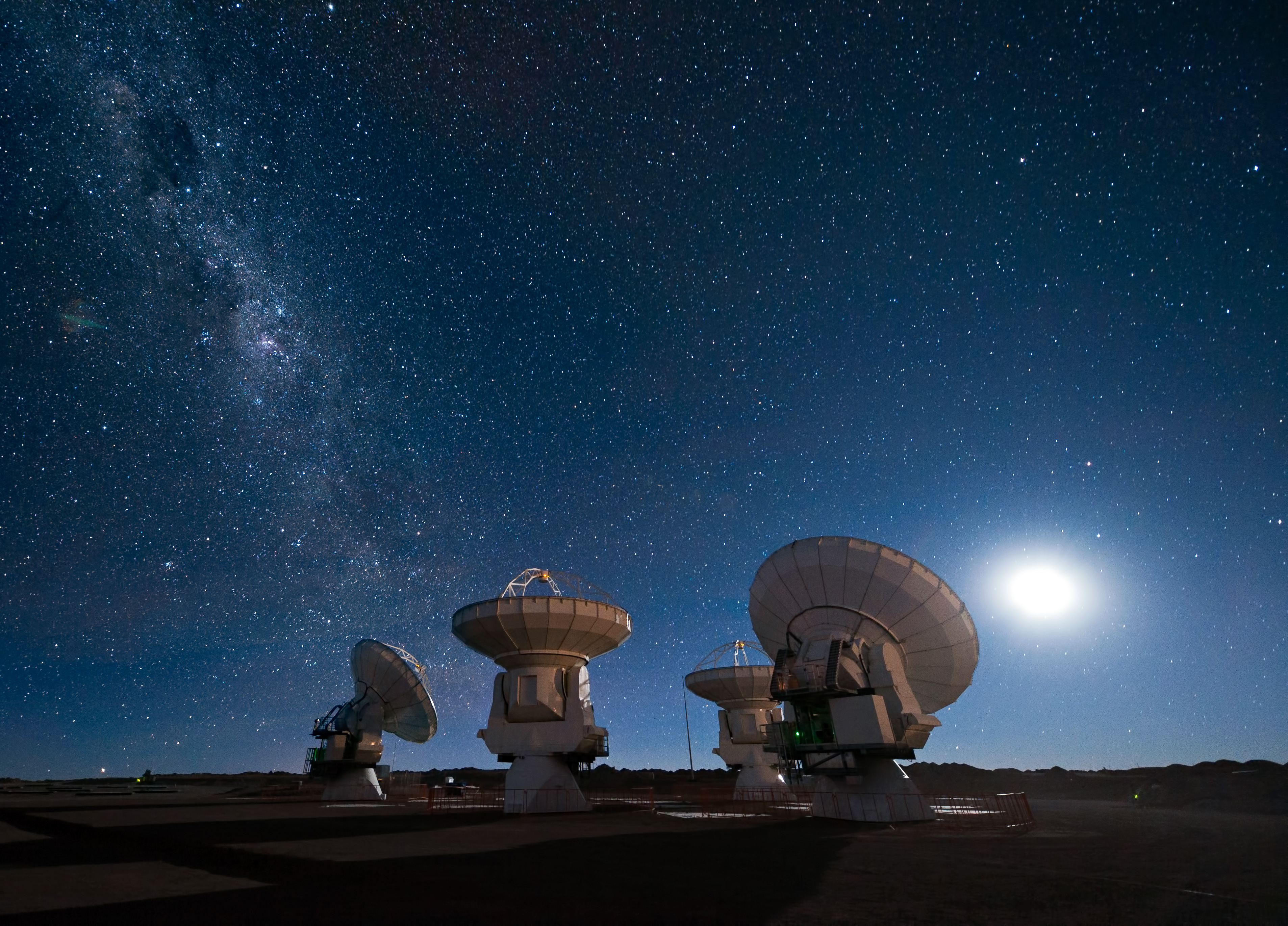|
High Elevation Antarctic Terahertz Telescope
The High Elevation Antarctic Terahertz telescope is a far-infrared telescope, established by the University of Arizona and the University of New South Wales located at Ridge A at an altitude of , considered the most ideal location for observation in the world. The extraordinary low humidity makes Inner Antarctica the best (by far) region for submillimeter astronomy observations. The telescope is robotic, remote controlled. It is mostly operated during the local winter, when the average temperature is . See also * List of astronomical observatories *List of radio telescopes This is a list of radio telescopes – over one hundred – that are or have been used for radio astronomy. The list includes both single dishes and interferometric arrays. The list is sorted by region, then by name; unnamed telescopes are in r ... References Astronomical telescopes and observatories in the Antarctic Infrared telescopes 2012 establishments in Antarctica {{observatory-stub ... [...More Info...] [...Related Items...] OR: [Wikipedia] [Google] [Baidu] |
University Of Arizona
The University of Arizona (Arizona, U of A, UArizona, or UA) is a public land-grant research university in Tucson, Arizona. Founded in 1885 by the 13th Arizona Territorial Legislature, it was the first university in the Arizona Territory. The university is part of the Association of American Universities and the Universities Research Association. In the former, it is the only member from the state of Arizona. The university is classified among "R1: Doctoral Universities – Very High Research Activity". The University of Arizona is one of three universities governed by the Arizona Board of Regents. , the university enrolled 49,471 students in 19 separate colleges/schools, including the University of Arizona College of Medicine in Tucson and Phoenix and the James E. Rogers College of Law, and is affiliated with two academic medical centers ( Banner – University Medical Center Tucson and Banner – University Medical Center Phoenix). In 2021, University of Arizona acquired ... [...More Info...] [...Related Items...] OR: [Wikipedia] [Google] [Baidu] |
University Of New South Wales
The University of New South Wales (UNSW), also known as UNSW Sydney, is a public research university based in Sydney, New South Wales, Australia. It is one of the founding members of Group of Eight, a coalition of Australian research-intensive universities. Established in 1949, UNSW is a research university, ranked 44th in the world in the 2021 ''QS World University Rankings'' and 67th in the world in the 2021 ''Times Higher Education World University Rankings''. It is one of the members of Universitas 21, a global network of research universities. It has international exchange and research partnerships with over 200 universities around the world. According to the 2021 QS World University Rankings by Subject, UNSW is ranked top 20 in the world for Law, Accounting and Finance, and 1st in Australia for Mathematics, Engineering and Technology. UNSW is also one of the leading Australian universities in Medicine, where the median ATAR (Australian university entrance examination re ... [...More Info...] [...Related Items...] OR: [Wikipedia] [Google] [Baidu] |
Ridge A
Ridge A is a site in Antarctica that was identified in 2009 as the best suited location on the surface of Earth for astronomical research. The site, approximately from the South Pole and southeast of Dome A, is situated in a portion of Antarctica claimed by Australia in the Australian Antarctic Territory. The site is on the Antarctic Plateau at an altitude of , and has an average winter temperature of . It is possible that this site may have even lower temperatures than Dome A, with temperatures that might as low or even colder than the ''legendary'' mark of -100°C (-148°F). Ridge A was identified by a team of Australian and American scientists searching for the best observatory spot in the world. The team leader described the site as "so calm there's almost no wind or weather there at all."Kenber, Billy"Scientists identify coldest place on earth" ''The Telegraph'', September 1, 2009. Accessed September 9, 2009. Ridge A is a low ridge of ice and has been estimated to have very ... [...More Info...] [...Related Items...] OR: [Wikipedia] [Google] [Baidu] |
Submillimeter Astronomy
Submillimetre astronomy or submillimeter astronomy (see spelling differences) is the branch of observational astronomy that is conducted at submillimetre wavelengths (i.e., terahertz radiation) of the electromagnetic spectrum. Astronomers place the submillimetre waveband between the far-infrared and microwave wavebands, typically taken to be between a few hundred micrometres and a millimetre. It is still common in submillimetre astronomy to quote wavelengths in 'microns', the old name for micrometre. Using submillimetre observations, astronomers examine molecular clouds and dark cloud cores with a goal of clarifying the process of star formation from earliest collapse to stellar birth. Submillimetre observations of these dark clouds can be used to determine chemical abundances and cooling mechanisms for the molecules which comprise them. In addition, submillimetre observations give information on the mechanisms for the formation and evolution of galaxies. From the gro ... [...More Info...] [...Related Items...] OR: [Wikipedia] [Google] [Baidu] |
List Of Astronomical Observatories
This is a list of astronomical observatories ordered by name, along with initial dates of operation (where an accurate date is available) and location. The list also includes a final year of operation for many observatories that are no longer in operation. While other sciences, such as volcanology and meteorology, also use facilities called observatories for research and observations, this list is limited to observatories that are used to observe celestial objects. Astronomical observatories are mainly divided into four categories: space-based, airborne, ground-based, and underground-based. Many modern telescopes and observatories are located in space to observe astronomical objects in wavelengths of the electromagnetic spectrum that cannot penetrate the Earth's atmosphere (such as ultraviolet radiation, X-rays, and gamma rays) and are thus impossible to observe using ground-based telescopes. Being above the atmosphere, these space observatories can also avoid the effects of atmo ... [...More Info...] [...Related Items...] OR: [Wikipedia] [Google] [Baidu] |
List Of Radio Telescopes
This is a list of radio telescopes – over one hundred – that are or have been used for radio astronomy. The list includes both single dishes and interferometric arrays. The list is sorted by region, then by name; unnamed telescopes are in reverse size order at the end of the list. The first radio telescope was invented in 1932, when Karl Jansky at Bell Telephone Laboratories observed radiation coming from the Milky Way. Africa Antarctica Asia Australia Europe North America South America Arctic Ocean Atlantic Ocean Indian Ocean Pacific Ocean Space-based Under construction or planned construction Proposed telescopes Gallery of big dishes File:FastTelescope*8sep2015.jpg, alt=Five hundred meter Aperture Spherical Telescope under construction, The 500 meter Five hundred meter Aperture Spherical Telescope (FAST), under construction, China (2016) File:GBT.png, alt=Green Bank Telescope, The 100 meter Green Bank Telescope, ... [...More Info...] [...Related Items...] OR: [Wikipedia] [Google] [Baidu] |
Astronomical Telescopes And Observatories In The Antarctic
Astronomy () is a natural science that studies celestial objects and phenomena. It uses mathematics, physics, and chemistry in order to explain their origin and evolution. Objects of interest include planets, moons, stars, nebulae, galaxies, and comets. Relevant phenomena include supernova explosions, gamma ray bursts, quasars, blazars, pulsars, and cosmic microwave background radiation. More generally, astronomy studies everything that originates beyond Earth's atmosphere. Cosmology is a branch of astronomy that studies the universe as a whole. Astronomy is one of the oldest natural sciences. The early civilizations in recorded history made methodical observations of the night sky. These include the Babylonians, Greeks, Indians, Egyptians, Chinese, Maya, and many ancient indigenous peoples of the Americas. In the past, astronomy included disciplines as diverse as astrometry, celestial navigation, observational astronomy, and the making of calendars. Nowadays, professional a ... [...More Info...] [...Related Items...] OR: [Wikipedia] [Google] [Baidu] |
Infrared Telescopes
An infrared telescope is a telescope that uses infrared light to detect celestial bodies. Infrared light is one of several types of radiation present in the electromagnetic spectrum. All celestial objects with a temperature above absolute zero emit some form of electromagnetic radiation. In order to study the universe, scientists use several different types of telescopes to detect these different types of emitted radiation in the electromagnetic spectrum. Some of these are gamma ray, x-ray, ultra-violet, regular visible light (optical), as well as infrared telescopes. Leading discoveries There were several key developments that led to the invention of the infrared telescope: * In 1800, William Herschel discovered infrared radiation. * In 1878, Samuel Pierpoint Langley created the first bolometer. This was a very sensitive instrument that could electrically detect incredibly small changes in temperature in the infrared spectrum. * Thomas Edison used an alternative technology, ... [...More Info...] [...Related Items...] OR: [Wikipedia] [Google] [Baidu] |
.jpg)

.jpg)


